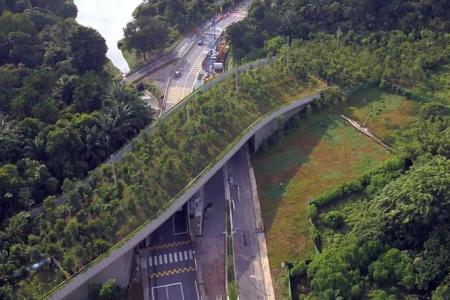Mandai Lake Road bridge used by wildlife, but does not eliminate roadkill incidents
Nearly 70 wildlife species including mammals and birds have been spotted using a bridge meant to provide wild animals with safe passage across Mandai Lake Road since the structure was opened in December 2019.
The developer of the site, Mandai Wildlife Group, gave this update on Thursday (Feb 3), saying camera traps installed along the 140m-long bridge have yielded insights into movements by common palm civets, wild boars, and sambar deer across the structure.
But The Straits Times has learnt that despite the bridge, which was constructed to protect native animals from traffic incidents along Mandai Lake Road, has not eliminated the risk that traffic poses to them.
In one accidenta year ago, a critically endangered Sunda pangolin was killed, its carcass found on Mandai Lake Road.
According to an incident report by Mandai Wildlife Group was seen by ST, the pangolin's death was likely caused by a vehicle strike, "based on the carcass condition and location".
"Possible points of access are being investigated and contractors are reminded to conduct daily checks on the hoarding and fencing," the incident report noted.
ST understands that other animals have also been found dead on Mandai Lake Road since December 2019, including two long-tailed macaques and a Malayan colugo.
The issue of native animals turning up dead alongthat stretch of road has been a sore spot for the nature community here since development plans to convert the secondary forests in the area to an eco-tourism hub were announced years ago.
Mandai Wildlife Group is developing the leafy Mandai area, which is located next to the biodiversity-rich Central Catchment Nature Reserve, into a hub of five wildlife parks.
Works for the Rainforest Wild park and the relocated Bird Park - renamed Bird Paradise - have been ongoing since January 2017. The Group said last October that the Bird Paradise is expected to open this yearand the Rainforest Wild park by 2024.
When completed, they will complement the existing three parks there - the Singapore Zoo, Night Safari and River Wonders.
In March 2018, ST reported that native animals that once called the Mandai forests home appear to have been pushed out onto the roads by the development, which involved the clearing of secondary forests .
Several native animals were found as roadkill either inside or within 500m of the project boundary within the first year or so of development.
At that time, Mandai Wildlife Group said that an average of one to two animals are run over on Mandai Lake Road each week - the same as before works started. But their records extend to November 2016, two months before work commenced.
No official data on roadkill incidents on Mandai Lake Road exists, but records from wildlife rescue group Animal Concerns Research and Education Society (Acres) show it was alerted to just one incident involving a monkey on Mandai Lake Road in 2016.
On Thursday, Mandai Wildlife Group said it has implemented permanent fencing along Mandai Lake Road to guide and funnel animals onto the wildlife bridge. Other crossing aids such as rope bridges have also been installed along the road, alongside signs urging motorists to slow down.
Ms Chua Yen Kheng, assistant vice president of sustainable solutions at Mandai Wildlife Group, said the Mandai Wildlife Bridge creates "vital habitat connectivity and safe passage for wildlife movement".
She added: "The commonly encountered animals in the surrounding forested areas have adapted well to the bridge. These include the sambar deer, wild pigs, long-tailed macaques as well as different bird species which have been observed nesting on planted trees."
The wildlife bridge had been planted with fast-growing native trees and a combination of species that grow to various heights at maturity, to achieve a multi-layered forest structure conducive for different animal species, Mandai Wildlife Group said.
"To enrich the ground layer on the bridge, logs, branches and leaf litter from the existing wildlife parks were collected and transported to the bridge," said the developer in a statement.
Log piles act as 'stepping stones' or refuge for small mammals, reptiles and amphibians, while saplings salvaged from other sites within the precinct have been transplanted onto the bridge.
Saplings of recently discovered and locally threatened tree species Glochidion obscurum have also been found growing on the bridge. They are the result of animal dispersal, a positive indicator of natural regeneration of flora on the bridge, said Mandai Wildlife Group.
The Group's Ms Chua added: "When the vegetation is mature, we expect that elusive species like the lesser mousedeer and Sunda pangolins will use the bridge to move between the forest patches.
"Our learnings from designing and deploying various wildlife-friendly features in a built environment are also potentially useful for projects elsewhere."
ST has approached Mandai Wildlife Group for their response to the roadkill incidents since the wildlife bridge was opened for the animals to use.
Get The New Paper on your phone with the free TNP app. Download from the Apple App Store or Google Play Store now


